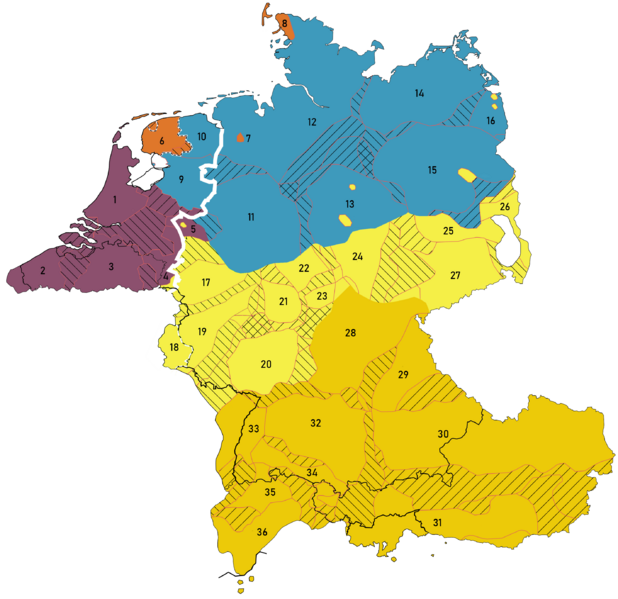Archivo: West Germanic dialect continuum (according to Wiesinger, Heeroma & König)

Descripción: A map describing the principal dialect groupings of the closed West Germanic dialect continuum between German, Frisian, Low Franconian and Low Saxon / Low German after 1945. Based on: W. Heeringa: Measuring Dialect Pronunciation Differences using Levenshtein Distance, University of Groningen, 2009, pp. 232-234. P. Wiesinger: Die Einteilung der deutschen Dialekte. In: Dialektologie. Ein Handbuch zur deutschen und allgemeinen Dialektforschung, series: HSK 1.2, Berlin, New York, pp. 807-900 W. König: dtv-Altas Deutsche Sprache, 2019, Munich, pp. 230. J. Goossens: Deutsche Dialektologie, Walter de Gruyter, 1977, pp. 48. C. Giesbers: Dialecten op de grens van twee talen, Radboud Universiteit Nijmegen, 2008, pp. 233. Legend: Lines The thin white/black dashed line represents the area in which two Dachsprachen are present: Standard Dutch (alongside Standard West Frisian) in the Netherlands, and Luxemburgish (alongside Standard German) in Luxemburg. The thick white line represents Standard Language isogloss (Goossens) between the dialects for which Dutch is the standard language (to the left of the line) and those for whom German is the standard language (right of the line). Striped lines indicate transitional dialects. Low Franconian / Netherlandic varieties: (purple) 1. Central Dutch 2. West Flemish 3. Brabantic 4. Limburgian 5. Lower Rhenish Frisian varieties: (orange) 6. West Frisian 7. Saterlandic (last remnant of East Frisian) 8. North Frisian Low Saxon / Low German varieties: (blue) 9. Overijssels 10. Gronings 11. Westphalian 12. Northern Low German 13. Eastphalian (one yellow part inside is Erzgebirgisch in part of the Harz) 14. Mecklenburg-Pomeranian 15. Brandenburgish (the yellow part inside is Berlinian in Berlin) 16. Middle Pomeranian Note: Low Prussian is Low German as well, but its speakers were expelled after 1945. Middle German / Central German varieties: (yellow) 17. Ripuarian 18. Luxemburgish (a part of or descendant from Moselle Franconian) 19. Moselle Franconian 20. Rhine Franconian 21. Central Hessian 22. Northern Hessian 23. Eastern Hessian 24. Thuringian 25. Northern Upper Saxon 26. South Märkisch 27. Upper Saxon Note 1: The empty part near 25, 26, 27 isn't a lake but Sorbian, a Slavic variety. Note 2: Silesian and High Prussian are Middle German as well, but their speakers were expelled after 1945. Note 3: Transylvanian Saxon spoken in Transylvania (Romania) is missing on this map. Upper German varieties: (ochre) 28. Upper Franconian: East Franconian and South Franconian (South Rhine Franconian) 29. North Bavarian 30. Central Bavarian 31. South Bavarian 32. Swabian 33. Low Alemannic 34. Middle Alemannic 35. High Alemannic 36. Highest Alemannic Note: Cimbrian and Mócheno spoken in Italy are missing on this map.
Título: West Germanic dialect continuum (according to Wiesinger, Heeroma & König)
Créditos: Trabajo propio
Autor(a): Vlaemink
Términos del Uso: Creative Commons Attribution-Share Alike 4.0
Licencia: CC BY-SA 4.0
Enlace de Licencia: https://creativecommons.org/licenses/by-sa/4.0
¿Se exige la atribución?: Sí
Usos del archivo
La siguiente página enlaza a este archivo:

